My mom's Beef Mechado was more than just another ulam, it was our family's love language. Every birthday, the familiar sound of garlic sizzling and that unmistakable aroma of tomatoes and calamansi would smell through our home, a sure sign that mom was making her special beef mechado for my celebration.
The way she'd carefully tend to the pot, occasionally lifting the lid to let that rich orange sauce reduce to perfection, taught me that the best dishes aren't just about the ingredients, they're about patience and pangmatagalan na pagmamahal.
Now that I'm cooking it in my own kitchen, I've perfected my mom's techniques (though she'll still insist hers tastes better), and I'm excited to share this tried-and-tested Beef Mechado recipe with you. It's the kind of dish that turns ordinary rice into a feast, and leftovers (if you're lucky enough to have any) taste even better the next day.
This recipe captures everything you love about authentic Filipino Beef Mechado: fork-tender meat in that iconic orange sauce that's perfectly balanced between tomatoes, soy sauce, and calamansi, plus the traditional potatoes and carrots that soak up all that sabaw.
Once you master this recipe, your family will be requesting it for their birthdays, too! So let's get cooking. I'll walk you through every step to make sure your mechado comes out exactly the way our moms and lolas made it.
Jump to:
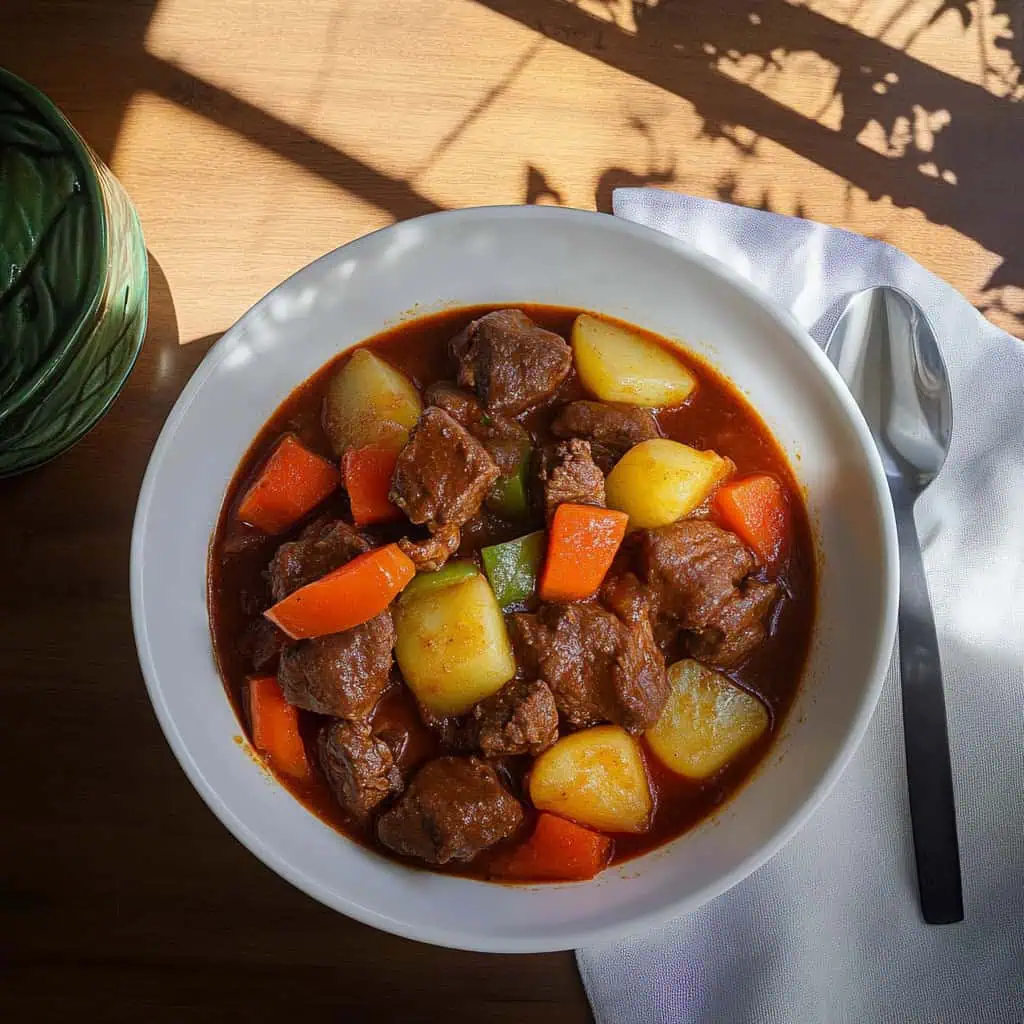
Why You'll Love This Recipe
- Fork-tender Meat: Learn the traditional "larding" technique that ensures melt-in-your-mouth beef
- Rich Sauce: Master the perfect balance of tomato, soy sauce, and calamansi that will have your family scraping their plates
- Make-Ahead Friendly: Actually tastes better the next day, perfect for meal prep
- Family-Approved: A true Filipino celebration dish that's impressive yet achievable
- Budget-Friendly: Transform affordable cuts into a premium-tasting dish
Ingredients
Each component in this recipe serves a specific purpose in creating the perfect Beef Mechado. Chuck roast provides the ideal balance of meat and fat for slow cooking, while the calamansi-soy marinade tenderizes and infuses the beef with classic Filipino flavors.
Garlic and onions create the aromatic base, while tomato sauce delivers the signature orange color and tangy depth. Potatoes and carrots add heartiness and absorb the rich sauce, while bell peppers bring color and a touch of sweetness.
The optional pork fat honors the traditional larding technique that gives mechado its name, enhancing both flavor and tenderness.

For the Meat:
- 2 pounds (1 kg) beef chuck roast or top round, cut into 2-inch cubes
- ¼ pound (113g) pork back fat, cut into thin strips [optional]
For the Marinade:
- ¼ cup calamansi juice or lemon juice
- ¼ cup soy sauce
- 1 teaspoon ground black pepper
For the Stew:
- ¼ cup cooking oil
- 2 medium potatoes, peeled and quartered
- 2 medium carrots, peeled and cut into chunks
- 1 large onion, diced
- 6 cloves garlic, minced
- 1 cup tomato sauce
- 3 cups beef broth or water
- 2 bay leaves
- 1 red bell pepper, cut into chunks
- 1 green bell pepper, cut into chunks
- Salt to taste
Equipment
- Heavy-bottom pot or Dutch oven: Essential for even heat distribution and preventing scorching during the long cooking process
- Sharp knife: For cutting meat into uniform pieces and creating pockets for larding
- Cutting board: Preferably with a juice groove to catch marinade
- Measuring cups and spoons: For precise ingredient measurements
- Wooden spoon: Gentler on the pot than metal utensils; good for scraping fond from bottom
- Tongs: For easily turning meat pieces when browning
- Meat thermometer: To ensure perfect doneness (optional but helpful)
- Storage containers: For leftovers or meal prep
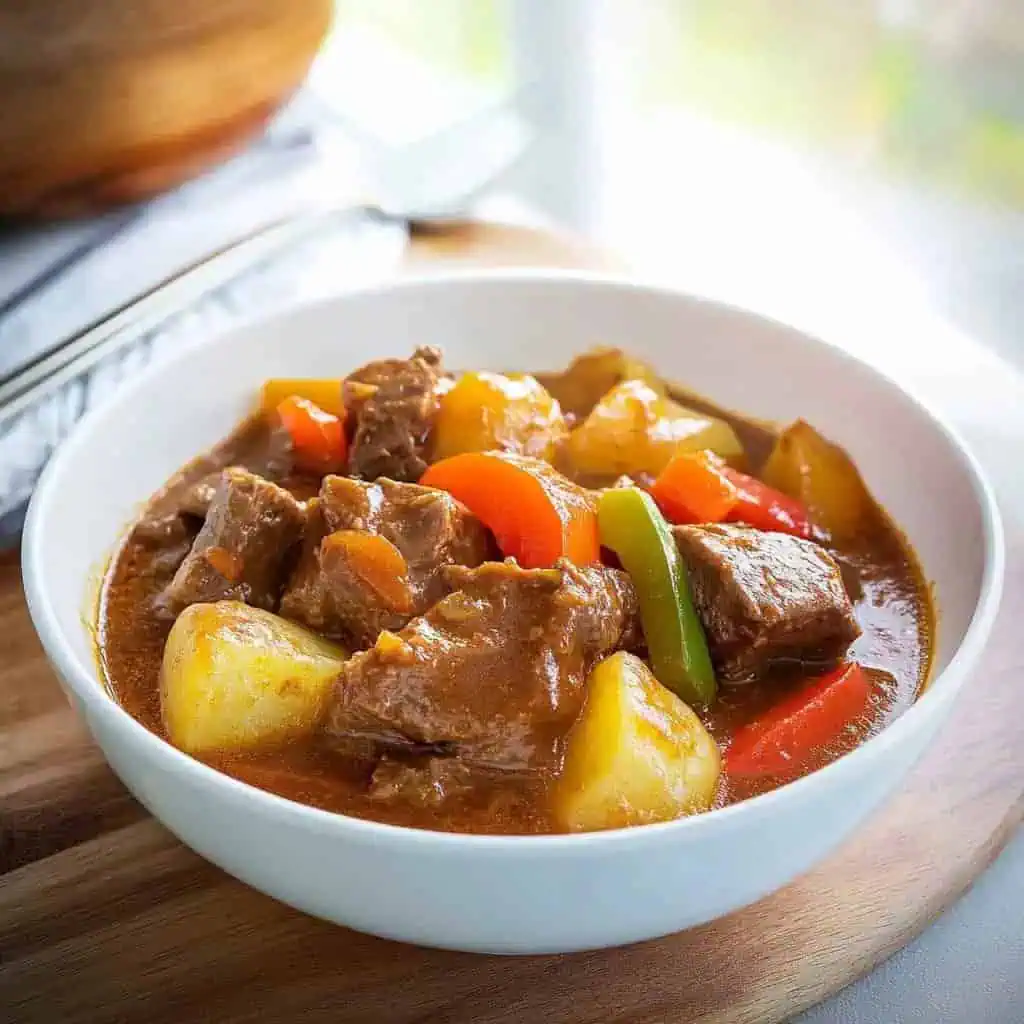
How To Make
- Prep the meat: Remove the beef from the refrigerator 30 minutes before cooking and pat dry with paper towels. Slice the beef chuck roast into uniform 2-inch cubes. If using pork fat, cut it into thin strips and insert these into the beef pieces using a small knife, making small pockets in the meat for the fat.
- Marinate: Combine calamansi juice and soy sauce in a bowl. Add the beef pieces and marinate for 30 minutes at room temperature. Meanwhile, prep your vegetables.
- Brown the vegetables: Heat your Dutch oven or heavy-bottomed pot to medium-high heat (375°F/190°C). Add cooking oil. Once hot, brown the potatoes and carrots until they develop a golden crust, about 5 minutes per side. Remove and set aside.
- Sauté aromatics: Using the same pot, maintain the heat at 350°F (175°C). Sauté the minced garlic until fragrant and lightly golden, about 1-2 minutes. Add the diced onions and cook until translucent, about 3-4 minutes.
- Brown the beef: Remove the beef from the marinade, but save the liquid. Brown the beef pieces in batches, ensuring each piece has enough space to develop a good sear. This should take about 5-7 minutes per batch. Avoid overcrowding the pot as this will cause the meat to steam rather than brown.
- Create the base: Once all the beef is browned, return all meat to the pot and add the reserved marinade. Let it reduce slightly, scraping the bottom of the pot to release any browned bits. Pour in the tomato sauce and beef broth. Add the bay leaves.
- Simmer: Reduce the heat to 300°F (150°C) and bring to a gentle simmer. Cover and cook for about 1.5 hours, or until the beef starts to become tender. Check occasionally and add more broth if needed to keep the meat partially submerged.
- Add vegetables: When the beef is nearly tender (internal temperature around 190°F/88°C), add back the browned potatoes and carrots. Continue cooking for about 20 minutes until the vegetables are tender but not mushy.
- Finish: Add the bell peppers in the last 5 minutes of cooking. The beef should be fork-tender at this point, reaching an internal temperature of 200-205°F (93-96°C). Season with salt to taste.
- Rest: Turn off the heat and let the mechado rest for 15 minutes before serving. This allows the meat to become even more tender and the flavors to settle.
- Serve: Enjoy hot over steamed white rice. You can offer additional calamansi halves on the side for extra tartness, and some pickled papaya (atchara) as a traditional accompaniment.

Tips from Lola's Kitchen
- Choose the right meat: Select beef with visible marbling for better flavor. Chuck roast is ideal as it has the right amount of fat and connective tissue that breaks down during slow cooking.
- Master the searing process: Don't rush browning the meat. Proper searing builds flavor through the Maillard reaction, creating those delicious caramelized notes.
- The secret to tender meat: If the meat is still tough after the recommended cooking time, don't panic. Simply continue cooking at a low simmer until it reaches fork-tender perfection. Different cuts and meat quality can affect cooking time.
- Develop depth of flavor: For an extra layer of umami, add a tablespoon of patis (fish sauce) toward the end of cooking.
- Balance is key: The perfect mechado has a harmonious balance of sour, salty, and savory. Taste as you go and adjust accordingly.
- Let it rest: The 15-minute rest period is non-negotiable! This allows the meat fibers to relax and reabsorb juices, resulting in more tender meat.
- Better the next day: Make your mechado a day ahead if possible, as the flavors deepen and meld overnight.
Substitutions
- Instead of beef chuck: Use beef brisket, short ribs, or even pork shoulder for a different but delicious variation.
- No calamansi?: Use a mix of lemon and lime juice in equal parts, or just lemon juice with a touch of orange juice for complexity.
- Tomato sauce alternatives: Crushed tomatoes mixed with a tablespoon of tomato paste works great. For a uniquely Filipino twist, try using banana ketchup (adjust sugar accordingly).
- Broth options: Chicken broth or even vegetable broth can work in a pinch. For deeper flavor, dissolve beef bouillon in warm water.
- Bell pepper substitutes: Mini sweet peppers, cubanelle peppers, or even a tablespoon of paprika can provide the sweet pepper flavor.
- No pork fat for larding: Simply skip this step. Modern versions often omit larding entirely, relying on marbling in the beef and proper cooking technique for tenderness.
Troubleshooting
Meat is tough:
- Continue cooking at a lower temperature. Tough meat usually means it needs more time to break down collagen.
- Make sure your simmer is gentle – too high heat can toughen proteins.
- Next time, try cutting the meat into smaller, more uniform pieces.
Sauce is too thin:
- Remove the lid and simmer uncovered to reduce the sauce.
- Mash a few pieces of the cooked potato and stir back into the sauce.
- For a controlled thickening, mix 1 teaspoon cornstarch with 1 tablespoon cold water and stir into the simmering stew.
Sauce is too thick:
- Add warm beef broth or water in small increments until desired consistency is reached.
- Remember that the sauce will thicken further as it cools.
Vegetables are mushy:
- In your next batch, add vegetables later in the cooking process.
- Brown them more thoroughly at the beginning to help them maintain structure.
- Cut vegetables into larger pieces if you prefer them firmer in the final dish.
Too salty:
- Add a quartered potato to absorb some salt, then remove before serving.
- Dilute with additional unsalted broth and a squeeze of calamansi.
- Balance with a pinch of sugar and additional acids like calamansi juice.
Not enough flavor:
- Boost umami with a splash of patis (fish sauce) or a small amount of oyster sauce.
- Add more freshly ground black pepper.
- Enhance with a tablespoon of Filipino liver spread for richness.
Storage & Reheating
Refrigeration:
- Cool completely before storing in airtight containers.
- Keeps well in the refrigerator for 3-4 days.
- The flavor actually improves overnight as the spices and seasonings meld.
Freezing:
- Freeze in portion-sized containers for up to 3 months.
- Leave about an inch of space at the top of containers to allow for expansion.
- Label with the date and contents for easy identification.
Reheating:
- Thaw frozen mechado overnight in the refrigerator.
- Reheat gently on the stovetop over low-medium heat (275°F/135°C).
- Add a splash of beef broth if the sauce has thickened too much.
- Stir occasionally to ensure even heating and prevent scorching.
- Heat until the internal temperature reaches 165°F (74°C) for food safety.
- Avoid microwaving if possible, as it can toughen the meat and create hot spots.
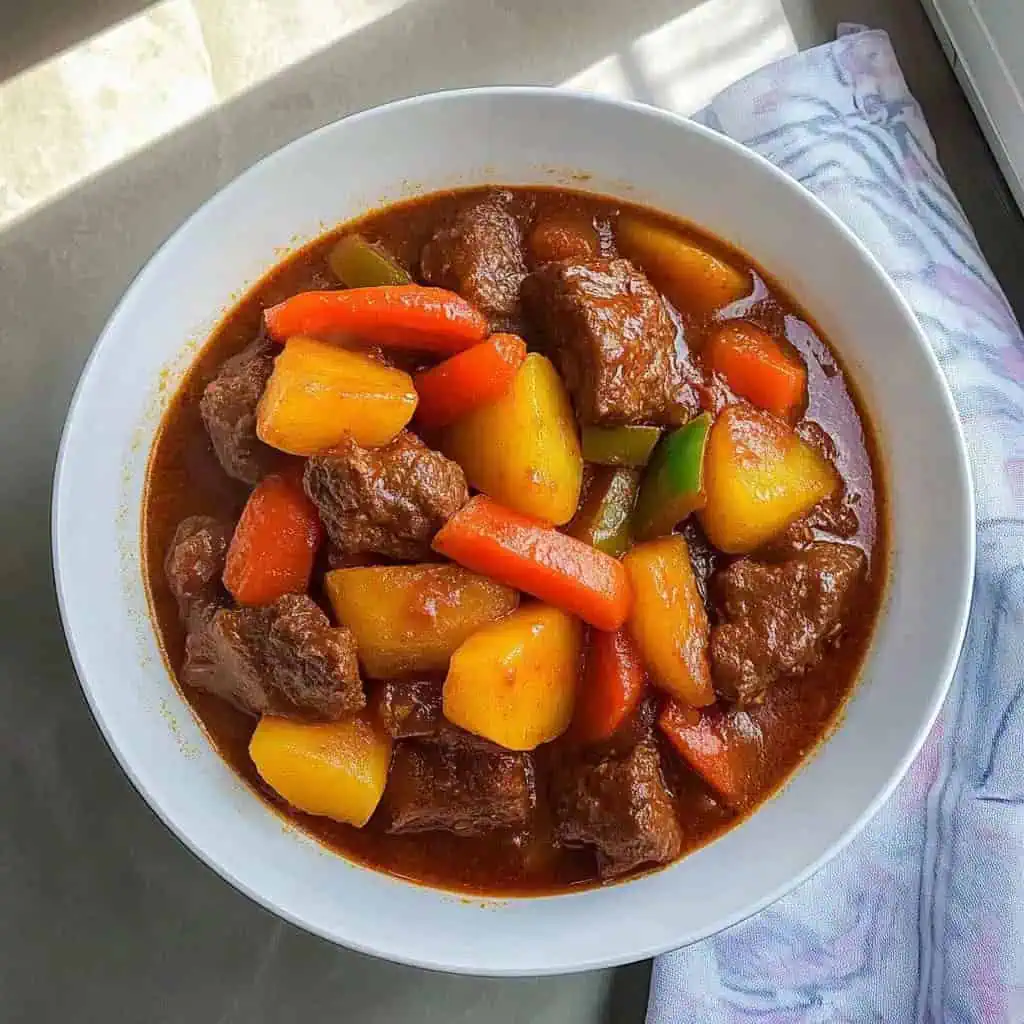
FAQ
What's the best cut of beef to use for mechado?
Chuck roast is ideal due to its good marbling and connective tissue that breaks down during cooking. Top round and brisket are excellent alternatives. Look for meat with good marbling for the most flavor.
Can I cook mechado in a pressure cooker or Instant Pot?
Absolutely! Pressure cooking reduces the cooking time significantly. Brown the meat and vegetables as directed, then pressure cook on high for 35 minutes with natural pressure release. Add the bell peppers after pressure cooking and simmer for a few minutes until tender.
How do I know when the beef is perfectly done?
Perfectly cooked mechado beef should easily pull apart with a fork. If you're using a thermometer, the internal temperature should reach 200-205°F (93-96°C), which is when collagen breaks down completely.
Can I make this recipe in advance for a party?
Yes, mechado is an excellent make-ahead dish! In fact, many Filipino cooks believe it tastes better after a day in the refrigerator as the flavors continue to develop. Simply reheat gently before serving.
What makes mechado different from kaldereta or afritada?
While these Filipino stews share similarities, mechado is distinguished by its soy sauce-calamansi marinade and the traditional larding technique. Kaldereta typically includes liver spread and sometimes olives, while afritada has a lighter tomato sauce and often includes green peas.
Is larding necessary for authentic mechado?
Traditionally yes, but modern versions often skip this step with excellent results. If you're looking for the most authentic experience, try the larding technique at least once. Many home cooks now rely on choosing well-marbled cuts of beef instead.
My family doesn't like bell peppers. Can I omit them?
Yes, you can omit the bell peppers without significantly affecting the dish. Consider adding a tablespoon of paprika for the sweet pepper flavor without the texture.
How can I make this more kid-friendly?
For children sensitive to strong flavors, reduce the black pepper and consider using less soy sauce in the marinade. You can also cut the vegetables into smaller, bite-sized pieces for easier eating.
Why is my mechado not as orange-red as restaurant versions?
Commercial versions often add annatto oil (atsuete) for a more vibrant color. You can make atsuete oil by steeping annatto seeds in hot oil until the oil turns red, then using this for sautéing.
Can vegetarians enjoy a version of mechado?
Yes! Try using firm tofu, seitan, or a mix of mushrooms (particularly king oyster mushrooms) as the protein base. Use vegetable broth and increase the soy sauce slightly for more umami depth.
Related
Looking for other recipes like this? Try these:
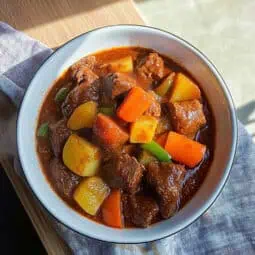
Filipino Beef Mechado (Mechadong Baka)
Equipment
- Heavy-bottom pot or Dutch oven
- Sharp knife
- Cutting board
- Measuring cups and spoons
- Wooden spoon
- Tongs
Ingredients
For the Meat
- 2 pounds 1 kg beef chuck roast or top round, cut into 2-inch cubes (karneng baka)
- ¼ pound 113g pork back fat, cut into thin strips (taba ng baboy) [optional]
For the Marinade
- ¼ cup calamansi juice katas ng kalamansi or lemon juice
- ¼ cup soy sauce toyo
- 1 teaspoon ground black pepper paminta
For the Stew
- ¼ cup cooking oil mantika
- 2 medium potatoes peeled and quartered (patatas)
- 2 medium carrots peeled and cut into chunks (karot)
- 1 large onion diced (sibuyas)
- 6 cloves garlic minced (bawang)
- 1 cup tomato sauce sarsa ng kamatis
- 3 cups beef broth or water sabaw ng baka
- 2 bay leaves dahon ng laurel
- 1 red bell pepper chunks (pulang bell pepper)
- 1 green bell pepper chunks (berdeng bell pepper)
- Salt to taste asin
Instructions
- Remove the beef from the refrigerator 30 minutes before cooking and pat dry with paper towels. Slice the beef chuck roast into uniform 2-inch cubes (karneng baka na hiniwa ng parisukat). If using pork fat (taba ng baboy), cut it into thin strips and insert these into the beef pieces using a small knife, making small pockets in the meat for the fat.
- Prepare your marinade by combining calamansi juice (katas ng kalamansi) and soy sauce (toyo) in a bowl. Add the beef pieces and marinate for 30 minutes at room temperature. While waiting, peel and quarter your potatoes (patatas) and carrots (karot), dice the onion (sibuyas), and mince the garlic (bawang).
- Heat your Dutch oven or heavy-bottomed pot (makapal na kaldero) to medium-high heat (375°F/190°C). Add cooking oil (mantika). Once the oil is hot, brown the potatoes and carrots until they develop a golden crust, about 5 minutes per side. Remove the vegetables and set aside.
- Using the same pot, maintain the heat at 350°F (175°C). Sauté the minced garlic until fragrant and lightly golden (hanggang mabango), about 1-2 minutes. Add the diced onions and cook until they become translucent (hanggang malabo), about 3-4 minutes.
- Remove the beef from the marinade, but save the liquid. Brown the beef pieces in batches in the pot, ensuring each piece has enough space to develop a good sear. This should take about 5-7 minutes per batch. Avoid overcrowding the pot (huwag masyadong punuin ang kawali) as this will cause the meat to steam rather than brown.
- Once all the beef is browned, return all meat to the pot and add the reserved marinade. Let it reduce slightly, scraping the bottom of the pot to release any browned bits (tutungin). Pour in the tomato sauce (sarsa ng kamatis) and beef broth (sabaw ng baka). Add the bay leaves (dahon ng laurel).
- Reduce the heat to 300°F (150°C) and bring to a gentle simmer. Cover and cook for about 1.5 hours, or until the beef starts to become tender. Check occasionally and add more broth if needed to keep the meat partially submerged.
- When the beef is nearly tender (internal temperature around 190°F/88°C), add back the browned potatoes and carrots. Continue cooking for about 20 minutes until the vegetables are tender but not mushy (malambot pero hindi masyadong luto).
- Add the bell peppers (paminta) in the last 5 minutes of cooking. The beef should be fork-tender at this point, reaching an internal temperature of 200-205°F (93-96°C). Season with salt (asin) to taste.
- Turn off the heat and let the mechado rest for 15 minutes before serving. This resting period allows the meat to become even more tender and the flavors to settle (pahupain). The sauce should be rich and slightly thick, coating the back of a spoon.
- Serve hot over steamed white rice (mainit na kanin). You can offer additional calamansi halves on the side for those who want extra tartness, and some pickled papaya (atchara) as a traditional accompaniment.
- For storage (pag-iimbak), let the mechado cool completely before transferring to an airtight container. It will keep in the refrigerator for up to 4 days. When reheating, warm gently on the stovetop over low heat (275°F/135°C), adding a splash of beef broth if the sauce has thickened too much.
- Remember, mechado often tastes even better the next day as the flavors continue to develop overnight. This makes it an excellent make-ahead dish for special occasions.
Tips from Lola's Kitchen
- Choose beef with visible marbling for better flavor
- "Magpatulo ng konting mantika" - Let a little oil drip: Don't rush the searing process
- "Pakuluan muna ang patatas" - Parboil potatoes first to ensure even cooking
- Use banana ketchup for a uniquely Filipino twist
- Let the stew rest for 15 minutes before serving for better flavor distribution
Nutrition
The Story Behind Filipino Beef Mechado (Mechadong Baka)
Growing up in Filipino households, the aroma of Beef Mechado simmering on Sunday afternoons tells a story that spans centuries of culinary ingenuity. This beloved dish, with its rich tomato-based sauce and tender beef, represents the perfect marriage of Spanish colonial influence and Filipino resourcefulness.
The name "Mechado" comes from the Spanish word "mecha," meaning wick, referring to the traditional technique of threading pork fat through cheaper cuts of beef – much like threading a wick through a candle. This culinary technique, known as larding, was taught by Spanish colonizers who had been using it in European kitchens to tenderize tough cuts of meat. Our Filipino ancestors embraced this method, adapting it to work with local ingredients and flavors.
What makes Filipino Mechado truly special is how it evolved beyond its Spanish roots. While the Spanish influence is clear in the larding technique and tomato-based sauce, Filipino cooks made it their own by incorporating distinctly Asian elements like soy sauce and calamansi. These additions created a uniquely Filipino flavor profile that perfectly balances savory, tangy, and umami notes.
In the early days, Mechado was considered a special occasion dish, often served during fiestas and family gatherings. The practice of larding was a clever way for Filipino families to transform affordable cuts of beef into something worthy of celebration. This resourcefulness reflects the Filipino spirit of "diskarte" – finding creative solutions to make the most of available ingredients.
Today's versions of Mechado have largely simplified the traditional larding process, but the dish remains a testament to Filipino culinary heritage. Whether prepared in a humble kitchen in the provinces or a modern Manila apartment, Beef Mechado continues to bring families together around the dinner table, just as it has for generations.
Modern Filipino home cooks may choose to skip the larding step entirely, letting the slow-cooking process and rich sauce do the work of tenderizing the meat. Yet, those who maintain the traditional preparation method insist that the threaded pork fat adds an unmatched depth of flavor and succulence that defines authentic Mechado.
From its Spanish colonial origins to its place on contemporary Filipino tables, Beef Mechado tells a story of cultural adaptation, family tradition, and culinary excellence. It's more than just a beef stew – it's a dish that carries the history of the Philippines in every flavorful bite.
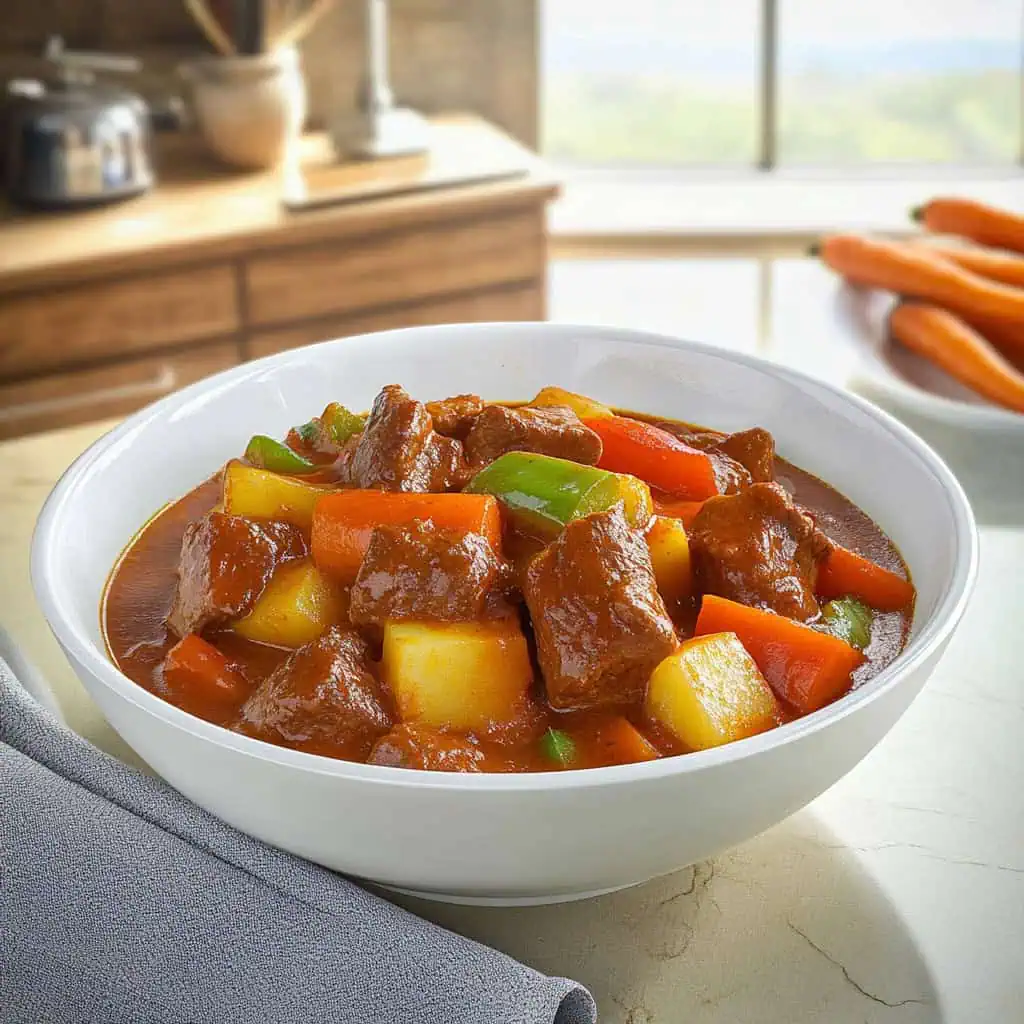









Comments
No Comments